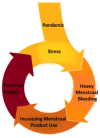Bleeding Through a Pandemic: Women's Lived Experiences with Heavy Menstrual Bleeding During the COVID-19 Pandemic
- PMID: 40264815
- PMCID: PMC12013634
- DOI: 10.2147/IJWH.S476959
Bleeding Through a Pandemic: Women's Lived Experiences with Heavy Menstrual Bleeding During the COVID-19 Pandemic
Abstract
Introduction: Heavy menstrual bleeding (menorrhagia) affects 10 million reproductive-age women. Stress is a mechanism for menstrual disorders, and during the COVID-19 pandemic, women reported worsening premenstrual and menstrual symptoms. We hypothesized that there would be a positive association between COVID stress and menorrhagia and a negative association between menorrhagia and mental health. A third objective was to explore women's lived experiences with menorrhagia during the pandemic, including menstrual pain and impact on socialization, sex life, and product use.
Methods: This was a secondary data analyses of a cross-sectional study that recruited adult women between the ages of 18-45 years using Dynata, a survey sampling company that maintains a web panel of survey takers across the United States. Menorrhagia was assessed with the Aberdeen Menorrhagia Severity Scale (AMSS), COVID stress with the COVID-19 Pandemic-related Perceived Stress Scale (PSS-10-C), and mental health with the Mental Health Continuum Scale (MHC-SF). We grouped the participants into mild menorrhagia (AMSS score 0-33)" and moderate/severe menorrhagia (AMSS score 34-100) and compared the outcomes using descriptive statistics, correlations, and linear regression.
Results: The survey was conducted in May 2021. Among 1,037 initial responses, 360 naturally cycling women met the study eligibility criteria. Women with heavy bleeding reported more COVID-stress than those without heavy bleeding (p < 0.01) and heavy bleeding intensified with increasing COVID-related stress (adj. β = 0.37, 95% CI: 0.21, 0.53). Adjusting for baseline depression, mental health worsened as heavy bleeding increased (adj. β = -0.1, 95% CI: -0.24, -0.03). Compared to those without heavy bleeding, women with heavy bleeding were more likely to report severe pain and bed confinement, less socialization, a negative impact on sex life, and greater use of menstrual products.
Conclusion: COVID-related stress affects menstrual physiology and also complex interactions between life-course, social functioning, financial strain, and psychological stress. Our findings support increased awareness of these interactions in gynecologic care during a global pandemic.
Keywords: COVID; COVID risk; COVID stress; heavy bleeding; menorrhagia; menstrual cup; menstruation; pandemic; women’s health.
© 2025 Anto-Ocrah et al.
Conflict of interest statement
The authors report no conflicts of interest in this work.
Figures





References
-
- Cw WMH, Borger J. Menorrhagia. StatPearls Publishing; 2024. https://www.ncbi.nlm.nih.gov/books/NBK536910/.
-
- Division of Blood Disorders. National center on birth defects and developmental disabilities, centers for disease control and prevention. Heavy Menstrual Bleeding, Available from:, https://www.cdc.gov/ncbddd/blooddisorders/women/menorrhagia.html#:~:text.... Accessed April 30, 2024.
-
- Mayo Clinic. Heavy menstrual bleeding. Available from:, https://www.mayoclinic.org/diseases-conditions/menorrhagia/symptoms-caus.... Accessed April 30, 2024.
LinkOut - more resources
Full Text Sources
Research Materials
Miscellaneous

